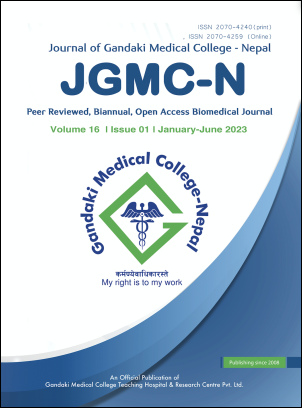Complementary feeding practices among mothers of 6-23 months of aged children at a tertiary level hospital in Nepal
DOI:
https://doi.org/10.3126/jgmcn.v16i1.54447Keywords:
Children, complementary feeding practices, tertiary level hospitalAbstract
Introduction: Complementary feeding is defined as the process starting when breast milk is no longer sufficient to meet the nutritional requirements of infants then other foods and liquids are needed, along with breast milk. This study was conducted to assess the complementary feeding practice among mothers of 6-23 months of aged children.
Methods: A cross-sectional study was conducted in Kathmandu among 240 mothers of 6-23 months of aged children attending the pediatric outpatient department and community medicine from June to September, 2022. A purposive sampling technique was used and data were collected using a structured questionnaire through a face-to-face interview. The obtained data were entered into Epi-data and converted into Statistical Package for the Social Sciences-20. Descriptive and inferential statistics were used for statistical analysis.
Results: The prevalence of Minimum Dietary Diversity (MDD),Minimum Meal Frequency (MMF), and Minimum Acceptable Diet (MAD) was 49.16% (0.42-0.55, 95% Confidence Interval), 44.58% (0.48-0.61, 95% Confidence Interval) and 27.91% (0.65-0.77, 95% Confidence Interval) respectively. Children of age 18-23 months were statistically significantly associated with MDD, MMF, and MAD respectively. Type of family, listening to radio as media, along with breastfeeding and bottle feeding since six months were statistically significantly associated with MMF and along with breastfeeding as well as bottle feeding since birth to six months were statistically significantly associated with MAD.
Conclusions: This study concluded that the children aged 18-23 months were more likely to have recommended standard complementary feeding practices than other younger-aged groups.
Downloads
Downloads
Published
How to Cite
Issue
Section
License
Copyright (c) 2023 Pratima Ghimire, Pratima Pathak, Bijaya Ghimire, Pramila Poudel, Kunja Shrestha, Rashmi Gachhadar, Pooja Gauro

This work is licensed under a Creative Commons Attribution-NonCommercial 4.0 International License.
This license allows reusers to distribute, remix, adapt, and build upon the material in any medium or format for noncommercial purposes only, and only so long as attribution is given to the creator.




